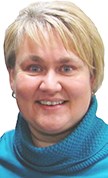I was in my second year of university when a discussion broke out just prior to class between people who had strong opinions on the events of an upcoming Remembrance Day. It began with a student asking where the nearest Remembrance Day service might be held, and ended with another student seriously questioning those taking part in anything related to the day. Several of us thoroughly disagreed with her position, but not with her right to say it. That's what freedom looks like.
I had the chance to tour the Parliament buildings in Ottawa on a beautiful April day many years ago. The iconic structure and grounds looked stunning against a vivid spring sky, marred only by the presence of a group of vocal protestors we needed to walk past. I didn't support the content of their protest, but I supported their right to be there. That's what freedom looks like.
Attendance at Remembrance Day ceremonies was expected to climb last year, up 10% from the previous year. One reason for an expected increase was the commemoration of 100 years since the end of the First World War. Communities, military bases, city halls and places of worship across our country held bell ringing ceremonies marking the occasion, replicating the bells that rang out across Europe signaling the end of the war.
On a cold day last November 11, I joined with others; witnesses to the poignant Bells of Peace ceremony; remembering those who served and the cost they paid. We stood in silence, listening as the ringing filled the air 100 times. Ten different representatives tolled the bell ten times on this solemn occasion, and as they did, the already uncomfortable temperature seemed to drop. Moments later we were on our way home, shedding the outerwear the cold clung to, and reaching for a blanket or cup of coffee to warm us up. To get comfortable again. Too comfortable.
Even with the special emphasis last year, still less than 40% of people planned to attend a Remembrance Day event. That is their choice, and of course they may do something else meaningful to mark the day. Or nothing at all. That's what freedom looks like.
Section 2 of the Canadian Charter of Rights and Freedoms grants us some pretty remarkable things. We can worship how we wish, or not at all. We can express our beliefs and opinions, or choose to stay quiet. We can gather with those we want and associate how we choose. We can vote; or not. We can discuss public policy. We can criticize our governments. Or support them. That's what freedom looks like.
Problems arise though, if we don't understand what these freedoms are worth. If we aren't diligent; if we aren't grateful; if we don't remember; we will see how quickly they are taken for granted, abused and lost.
The Bells of Peace remembrance took less than 15 minutes to observe. Fifteen minutes to mark 100 years of history that has unfolded as a result. History I have benefitted from. The privilege of peace so many in the world do not know.
From the comfort of my warm home I picked up the program we'd been given at the ceremony. In it was the statement, “The ceremony will proceed regardless of the weather. Fifteen minutes standing in the cold is a minor inconvenience, compared to the horror of Canadian soldiers who stood for endless days in the trenches.”
Few of us understand what it took. None of us would have what we have without their resolve. All of us need to remember the cost. If we're going to do what we do and say what we say using those freedoms as a shield, we better take the time to honor those whose sacrifice made it possible. The view from the trenches must be remembered, because that's what freedom looks like. That's my outlook.




